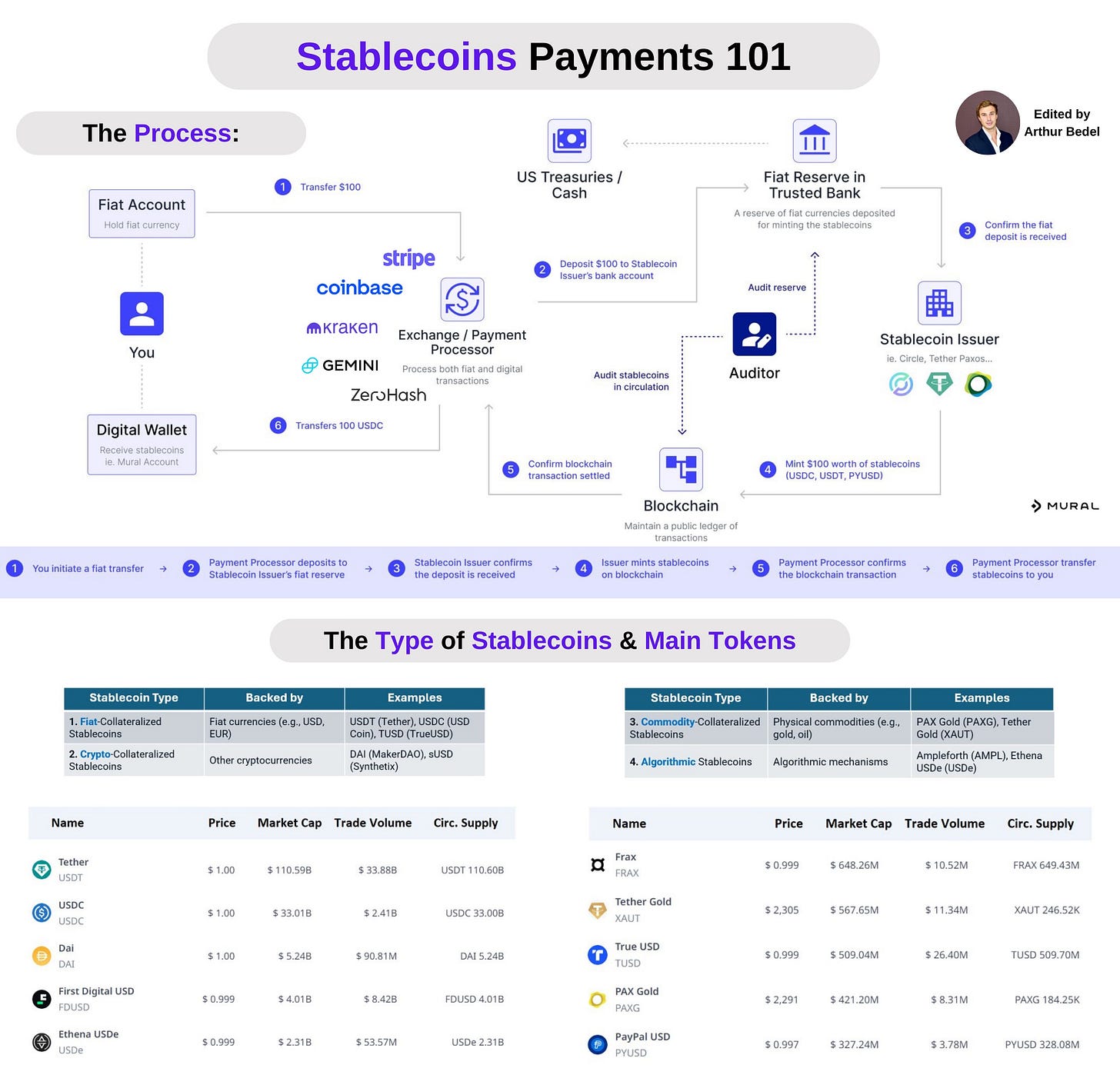Welcome to our latest edition of "Connecting the Dots in Payments with Arthur Bedel," where we explore the dynamic world of financial transactions and innovations alongside this esteemed payments professional. Join us as we uncover insights and trends shaping the future of payments
What are they, how do you pay with them, why Stablecoins and who are the main players 👇
What are Stablecoins:
Stablecoins are a type of cryptocurrency designed to maintain a stable value relative to a specific asset, usually a fiat currency like the USdollar or a commodity like gold.
Unlike traditional cryptocurrencies such as Bitcoin or Ethereum, which can experience significant price volatility, stablecoins aim to offer the best of both worlds:
👉 the instant processing and security of payments of cryptocurrencies
👉 the stable valuations of fiat currencies.
There are primarily 3 types of stablecoins:
🔸Fiat-collateralized stablecoins: These are backed by fiat currency at a 1:1 ratio. For every stablecoin issued, a certain amount of fiat currency is held in reserve, which can be bank deposits or government bonds. Examples include USDC (U.S. Dollar Coin) and Tether (USDT).
🔸 Crypto-collateralized stablecoins: These stablecoins are backed by other cryptocurrencies as collateral. Because the reserve cryptocurrency may also be volatile, such stablecoins often over-collateralize—holding more crypto in reserve than the stablecoins issued—to buffer against price fluctuations. An example is DAI, which is pegged against the U.S. dollar but backed by Ethereum.
🔸 Algorithmic stablecoins: Unlike the other types, these are not backed by any collateral but instead use algorithms to control the supply of the issued tokens, expanding and contracting it based on the changes in demand to maintain a stable value. This type can be more volatile and has been subject to failures when the underlying mechanisms do not perform as expected.
Stablecoins are popular for transactions, savings, and trading in the cryptocurrency market, especially as a hedge against the volatility of more speculative cryptocurrencies. They also play a crucial role in decentralized finance (DeFi) applications.
Main providers are both Blockchain Infrastructure Players & Exchanges:
🔸 Zero Hash, Circle, Coinbase, Kraken Digital Asset Exchange, Paxos etc...
The History & Benefits of Stablecoins:
Created in 2014, Tether (USDT) was the first widely recognized stablecoin bridging the gap between fiat and crypto currencies. In payments, they offer:
🔸Stability — They are pegged to stable assets like fiat currencies, they don't suffer from the same volatility as other cryptocurrencies, making them more suitable for everyday transactions.
🔸Speed and Efficiency — Faster than traditional bank transfers, especially across borders. They leverage blockchain technology, which can significantly reduce transaction times from days to minutes or even seconds.
🔸Lower Transaction Fees: Traditional cross-border transactions involve multiple intermediaries, each of which can add costs and delays. Stablecoins simplify the process, potentially lowering costs.
🔸Accessibility — Stablecoins can be accessed by anyone with an internet connection, bypassing the need for traditional banking infrastructure. This makes them particularly valuable in underbanked or unbanked regions, enhancing financial inclusion.
🔸 Transparency and Security — Transactions made with stablecoins are recorded on a blockchain, offering greater transparency and traceability than traditional financial systems.
🔸Regulatory Compliance — Many stablecoin issuers are increasingly focusing on compliance with regulatory frameworks, making them a more trusted medium of exchange in the eyes of consumers and businesses, as well as regulators.
🔸Integration with Digital Applications — Stablecoins are well-suited for integration into digital applications, smart contracts, and decentralized finance (DeFi) protocols, expanding their use cases beyond simple buy-and-sell transactions.
& many more 👋
👉 How do fiat-pegged stablecoins work exactly? There are mainly 6 steps :
Imagine you are exchanging $100 for 100 USDC to pay a contractor.
1 - You transfer $100 to an exchange or payment processor.
2 - The exchange or payment processor deposits this $100 to the stablecoin issuer's fiat reserve in a bank.
3 - The stablecoin issuer, such as Circle, Tether.to, or Paxos, confirms that the fiat deposit has been received.
4 - Then, the stablecoin issuer mints an equal amount of digital currency on the blockchain, in this case, 100 USDC.
5 - The exchange or payment processor confirms that the 100 USDC has been successfully minted.
6 - You receive 100 USDC.
That simple ✅
Stablecoins are bridging the gap between traditional payments and cryptocurrencies. They can't be ignored, no matter which side you are on. Slowly but surely they are gaining adoption globally 🚀
Source: Mural, Global X ETFs, Cryptobank, KuCoin Exchange
Sign up & Follow:
✍️ The Payments Brews ☕️: https://lnkd.in/g5cDhnjC
✍️ Connecting the dots in payments... & Marcel van Oost by Arthur Bedel




